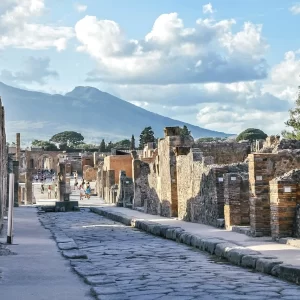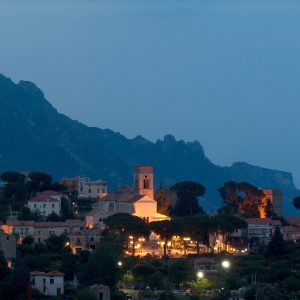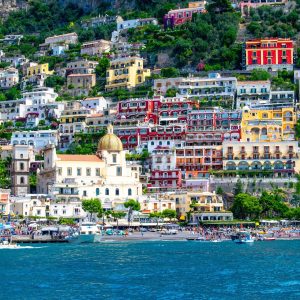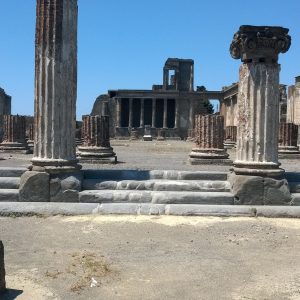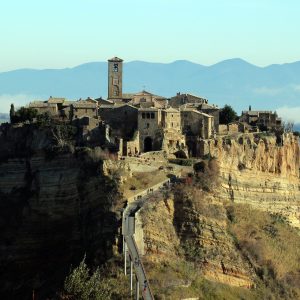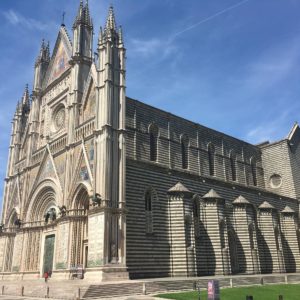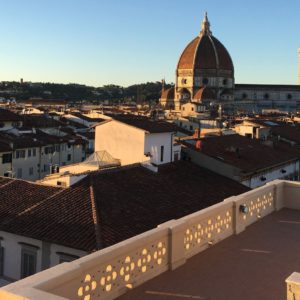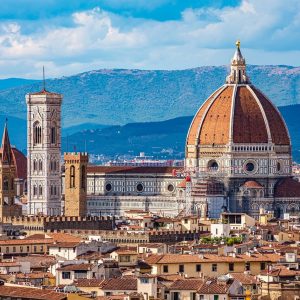The Battle of Montecassino
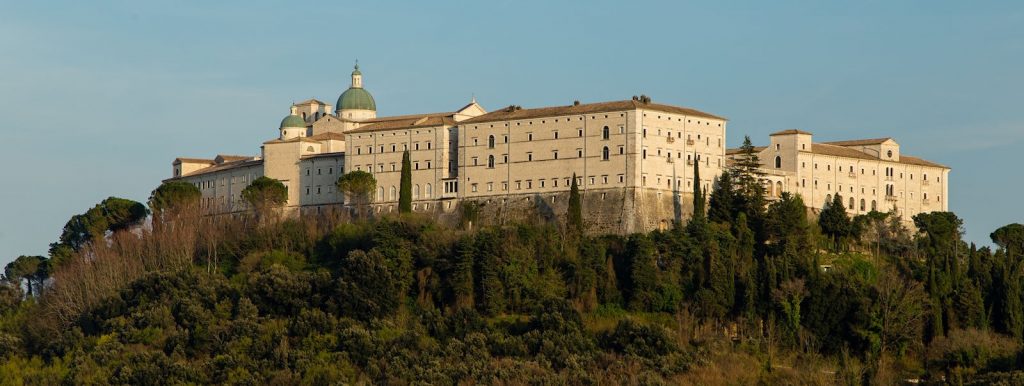 In July of 1943 the Allies started Operation Husky, a planned invasion of Italy from the south beginning with a massive landing in Sicily. The commanders were General Montgomery, leading the British Eighth Army, and General Patton, leading the American Fifth Army.
In July of 1943 the Allies started Operation Husky, a planned invasion of Italy from the south beginning with a massive landing in Sicily. The commanders were General Montgomery, leading the British Eighth Army, and General Patton, leading the American Fifth Army.
This was the first major operation on Italian soil during War World II, planned because Italy was considered the weakest part of the Axis Nazi-Fascist alliance.
The Allied Forces planned this strategy in order to distract the German troops who were concentrating on Northern Europe, by sending their army to Italy, hiding their real intention which was to invade Europe from the north at Normandy which they would subsequently do.
They first took Sicily, which was quite easy because the only resistance met was on the eastern side of the island by a few German troops.
The second stage was landing in Salerno on September 3, 1943. The military campaign was going smoothly for the Allies and after just one week they arrived to Naples.
At this point, their route, which was of course leading toward Italy’s most important city, Rome, became quite complicated due to the relocation of the Nazi troops that had formed a defensive line along the so-called Gustav line.
Then the Allies chose Montecassino to create a stronghold because of its location.
Montecassino is located in the hills between the Adriatic Sea and the Tyrrhenian Sea, between the Liri River, the Garigliano River and the Rapido River.
The last, unfortunately became a big obstacle for the Allied troops.
The main road leading to Rome in those years, Route 6, was the only way to arrive to Rome with so many heavy tanks, trucks and all the other army supplies.
The Allied Forces were composed of the armies of many different countries including: Poland, England, France, India, Australia, New Zealand and the USA.
The commander in chief of this particular operation was the American General Mark Clark who reported directly to General Alexander, responsible for the entire Italian campaign.
Montecassino and its monastery
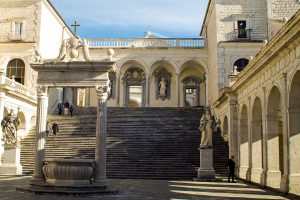 To really understand the events that happened, it is important to understand a little background about Montecassino.
To really understand the events that happened, it is important to understand a little background about Montecassino.
Perched on the hilltop is the monastery named Montecassino Abbey which was built in 529 by St. Benedict, who started the Benedictine order from here.
He first built a small chapel around the stone located at the bottom of the current building, the place he used for preaching to the faithful, praying and resting.
The monastery later was expanded to its current, very large form.
St. Benedict is very important for the Catholic Church and is the patron saint of Europe. His most famous saying was: “Ora et labora” which means pray and work. This was the philosophy he taught to his fellow monks that was handed down to each new generation.
The life in the monastery was regulated by cycles of prayer and work; but what kind of work did monks do at monasteries at that time?
First and foremost, the monks cultivated their land, often providing food for their local community.
These specific monks were also particularly skilled in making hand written copies of ancient manuscripts, an important job because printing presses had not been invented yet.
Imagine what an incredible job they did to preserve the past for future generations, including us.
The Battlefield, Montecassino in 1944
Returning to January 1944, Field Marshall Albert Kesserling, chief commander in Italy for the German troops, ordered the army to relocate towards the north to the Montecassino area, to build bunkers and different kinds of fortifications all over the hillside of Montecassino.
Their plan was to block the advance of the Allies by shooting them with big cannons, which from their privileged position was an easy job, especially because of the presence in the valley of the two rivers, Rapido and Liri, which complicated the Allied troop advance.
In fact, due to the total lack of vegetation, crossing those rivers was an impossible mission for the Allied soldiers who had no covering.
The battle
The battle proceeded in 4 different main assaults and losses for the Allied troops were extremely heavy. Because of this, General Clark made the decision to call in the Air Force to bomb the whole monastery.
This was a very difficult decision, because according to wartime rules, bombing or attacking religious sites is not permitted.
But General Clark, who was a great and expert general, was convinced that the German troops were inside the monastery.
Consequently, he ordered the bombing of the monastery, which was totally destroyed on the morning of February 15, 1944.
Later it became very clear that this had been a complete mistake because inside there were just 7 monks and more than 200 civilians who, in order to escape the bombing in the city of Cassino located at the bottom of the valley, had moved into the monastery for shelter.
The citizens were convinced that because it was a holy site it would be spared from actions of war.
In the end, the monks and some townspeople who were praying in the St. Benedict Chapel located below the monastery survived, while many others perished. It is thought my some to have been a miracle as only those people gathered praying near the stone of St. Benedict survived.
Three weeks prior, General Alexander, Commander in Chief of the Italian theater, upon realizing the impenetrability of the Gustav line, planned a maneuver to ease the pressure on the Gustav line to distract the German troops from the Montecassino area.
In fact, he planned another landing at Anzio, about 30 miles south of Rome, assigning the mission named “Operation Shingle” to the American General, John Lucas.
The landing on Anzio beach took place on January 22, 1944.
When the U.S. VI Corp lead by Lucas landed on the beach there was no enemies there to oppose them because most of the German troops were committed in the Montecassino battle.
He kept his soldiers on the beach rather than advancing immediately inland. This ill-thought-out plan had a huge cost in terms of human life because, very naively, Lucas gave the Nazi troops time to reach them resulting in another bloody battle.
Because of this tragic mistake, Lucas was fired immediately. After the fourth attempt to take Montecassino hill began on the May 11 with furious fighting, on May 18, 1944, the Polish troops of the 12nd Regiment took over the already abandoned ruins of the Montecassino Abbey. The Germans, in fact, left only wounded soldiers behind and moved north.
At this point the troops located at Anzio, now lead by General Truscott who replaced Lucas, were supposed to move towards the east in order to cut off the 10th German Army that was retiring towards the north, but incredibly General Clark ordered him to change his target moving on Valmontone instead, which was a more strategic move to reach Rome.
The reason why this change of strategy is very controversial lies in fact that it seems that General Clark was afraid that engaging in another battle with the 10th German Army would slow down his march towards Rome, giving the possibility to the English to enter Rome before him.
However, Clark was able to capture Rome on June 4, 1944 entering the city in triumph, just two days before the Normandy invasion.
Rome, was taken without any further fighting also because Kesserling had decided to have his entire army retreat towards the north as soon as possible where the Nazis were organizing another defensive line named the “Gothic line”.
This battle was finally finished in Rome and, if you come to Rome one day, you can visit the Pyramid of Cestius, the monument created to commemorate the Liberation of Rome from Nazi oppression.
Although the war didn’t end that day, and would indeed last another year, this battle was the real key to the final victory along with the other big battle that would start just a few days later: the invasion of Normandy.
In fact, keeping the 10th German Army committed for such a long time, exactly as planned by Eisenhower and Churchill, the German forces in Normandy and in the rest of Europe were not at their best.
American World War II cemeteries and museums
The Montecassino battle alone cost a total of 74,000 human lives, among them 54,000 were Allied troops.
If you want to come to Italy for a tour to retrace the path of this battle, you won’t want to miss the American War World II cemetery built at Nettuno, the city next to Anzio where one of the beach landings took place. In this cemetery, which is property of the U.S., there are about 8000 tombs with the typical white crosses, all in rows as is the norm for American war cemeteries.
Once inside, you can visit the very informative museum which features a path with panels, pictures, videos, written documents and some military items to learn about this historical moment. The cemetery is kept in perfect condition under the surveillance of the American Marines, who can help you in giving all the extra information you may need.
Moreover, they can also provide all the information and assistance you might require for finding a specific tomb. While the WWII American cemetery of Nettuno is the largest in Italy, there is also a smaller one located just outside of Florence where 4000 soldiers are buried who died during the campaign in the north of Italy.
Another interesting place to visit is the Anzio Beachhead Museum located in Anzio.
It was created at an initiative by members of the Research and Documentation Centre focusing on the landing and the battle of Anzio.
The museum is divided into four sections: American, English, German and Italian.
You can find on display uniforms, weapons, decorations, documents, battle plans, photos of veterans and everyday objects, all relics from this incredible battle.
A true story within the history
I have a side story to tell you about the Rapido River. A few years ago, I had the honor and privilege of accompanying an American family on a very special trip. This family had planned their entire trip to Italy around the important places of this battle, all the way from the beach in Salerno to Rome.
One of the family members was a very old man, close to his nineties, who was so happy and excited for this trip. He told me that he was one of the Texas Rangers who fought with his battalion in the battle of Montecassino.
He also told me that once his battalion arrived to the banks of the Rapido River they received the order to cross it in order to reach the hillside to get closer to the monastery and look for some shelter.
Unfortunately, they hadn’t a specific plan in place for doing this. They all knew that this mission was nearly impossible to complete as they would be very easy targets for the German soldiers positioned there.
He went on to describe the battle that ensued, something like out of the film “Saving Private Ryan” which became famous not only for its story but for the graphic violence it portrayed.
What followed was a complete massacre of his battalion, where 298 of the 300 men in his battalion died while trying to cross the river, and only this man and one of his comrades were lucky enough to survive.
As he was recounting this horrific tale, he began to weep and his voice faded. When we arrived to Cassino, he requested to be taken down by the river so he could see that place one last time.
He wanted to reflect on these dramatic moments one last time as he knew that he would likely never return due to his age.
His family and I took him down very close to the water’s edge and he walked the rest of the way by himself, trembling and softly crying remembering his fallen comrades.
He stayed there, alone with his memories before heading back to join us.
This experience touched me so much, which is why I wanted to share it with you. This Texas Ranger represents so very many men (actually oftentimes who were just boys) who sacrificed everything for the freedom of Italians and the entire world.
I was curious to know just how many soldiers died attempting to cross that river.
I found out that 1600 soldiers died in that spot and some 20,000 people died in the 4-month battle to capture Montecassino.
Hearing these incredible numbers makes me think that this incredible battle has been a bit lost in history, as most Americans I have met haven’t heard of it, but instead know the more famous Normandy battle as the bloodiest.
But I am certain that Montecassino with its 20,000 deaths has an important historical place that should be remembered by both Americans and Italians alike.
After a visit to the Montecassino monastery, which after the war was totally rebuilt, I took this client and his family to visit other sites where fighting had occurred on the way to Rome, including: Cisterna, Anzio (another important beach landing/point of conflict) and Nettuno, where the American Government built a World War II American cemetery. (foto American_cemetery-nettuno)
This client had organized his trip to coincide with a larger commemoration of that battle, during which President George W. Bush attended two ceremonies; one directly at the cemetery, and another one the day after at the American ambassador’s residence in Rome.
I was able to participate alongside my clients at both ceremonies. The first, in the cemetery, was a very official affair with press and other media and with American military personnel.
The second one, in Rome, was a private party organized in honor of the American veterans who participated in the World War II campaign in Italy.
Imagine how proud these very old men felt to be invited to these events organized to honor them and how their minds were in the past, remembering their comrades who are no longer alive. Imagine how proud their families were of their fathers.
While I felt like a bit of an outsider in all of this, because I’m not American, I also felt honored to be able to help them during this special time in Italy.



